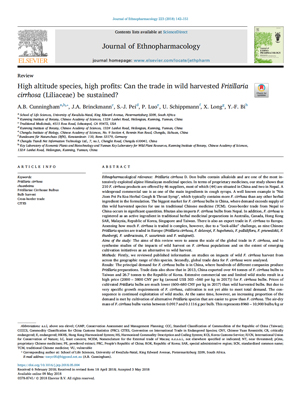NEWS 2018
High altitude species, high profits: can the trade in wild harvested Fritillaria cirrhosa (Liliaceae) be sustained?
A.B. CUNNINGHAMa, b, J.A. BRINCKMANNc, S-J. PEId, P. LUOVe, U. SCHIPPMANNf, X. LONGg, Y-F. BIh
Journal of Ethnopharmacology (2018)
https://doi.org/10.1016/j.jep.2018.05.004
a School of Life Sciences, University of KwaZulu-Natal, King Edward Avenue, Pietermaritzburg, 3209, South Africa b Kunming Institute of Botany, Chinese Academy of Sciences, 132# Lanhei Road, Heilongtan, Kunming, Yunnan, China c Traditional Medicinals, 4515 Ross Road, Sebastopol, California 95472, USA d Kunming Institute of Botany, Chinese Academy of Sciences, 132# Lanhei Road, Heilongtan, Kunming, Yunnan, China e Chengdu Institute of Biology, Chinese Academy of Sciences, No. 9 Section 4, Renmin Nan Road, Chengdu, Sichuan, China f Bundesamt für Naturschutz (BfN), Konstantinstr. 110, Bonn 53179, Germanyg Chengdu Tiandi Net Information Technology Ltd., 7, no.1, Chengfei Road, Chengdu, 610041, China h Key Laboratory of Economic Plants and Biotechnology and Yunnan Key Laboratory for Wild Plant Resources, Kunming Institute of Botany, Chinese Academy of Sciences, 132# Lanhei Road, Heilongtan, Kunming, Yunnan, China a
Abstract
Ethnopharmacological relevance
Fritillaria cirrhosa D. Don bulbs contain alkaloids and are one of the most intensively exploited alpine Himalayan medicinal species. In terms of proprietary medicines, our study shows that 210 F. cirrhosa products are offered by 46 suppliers, most of which (44) are situated in China and two in Nepal. A widepread commercial use is as one of the main ingredients in cough syrups. A well known example is "Nin Jiom Pei Pa Koa Herbal Cough & Throat Syrup", which typically contains more F. cirrhosa than any other herbal ingredient in the formulation. The biggest market for F. cirrhosa bulbs is China, where demand exceeds supply of this wild harvested species for use in traditional Chinese medicine (TCM). Cross-border trade from Nepal to China occurs in significant quantities. Bhutan also imports F. cirrhosa bulbs from Nepal. In addition, F. cirrhosa is registered as an active ingredient in traditional herbal medicinal preparations in Australia, Canada, Hong Kong SAR, Malaysia, Republic of Korea, Singapore and Taiwan. There is also an export trade in F. cirrhosa to Europe. Assessing how much F. cirrhosa is traded is complex, however, due to a “look-alike” challenge, as nine Chinese Fritillaria species are traded in Europe (Fritillaria cirrhosa, F. delavayi, F. hupehensis, F. pallidiflora, F. przewalskii, F. thunbergii, F. unibracteata, F. ussuriensis and F. walujewii).
Aims of the study
The aims of this review were to assess the scale of the global trade in F. cirrhosa, and to synthesise studies of the impacts of wild harvest on F. cirrhosa populations and on the extent of emerging cultivation initiatives as an alternative to wild harvest.
Methods
Firstly, we reviewed published information on studies on impacts of wild F. cirrhosa harvest from across the geographic range of this species. Secondly, global trade data for F. cirrhosa were analysed.
Results
The principal demand for F. cirrhosa bulbs is in China, where hundreds of different companies produce Fritillaria preparations. Trade data also show that in 2013, China exported over 44 tonnes of F. cirrhosa bulbs to Taiwan and 26.7 tonnes to the Republic of Korea. Extensive commercial use and limited wild stocks result in a high price (2,000 – 3,800 CNY per kg (around US$ 303 –560 per kg in 2017)) for F. cirrhosa bulbs. Prices of cultivated Fritillaria bulbs are much lower (600 - 680 CNY per kg in 2017) than wild harvested bulbs. But due to very specific growth requirements of F. cirrhosa, cultivation is not yet able to meet total demand. The consequence is continued exploitation of wild stocks. At the same time, however, an increasing proportion of the demand is met by cultivation of alternative Fritillaria species that are easier to grow than F. cirrhosa. The air-dry mass of F. cirrhosa bulbs varies between 0.0917 – 0.1116g per bulb. This represents 8960 – 10900 bulbs/kg or 8.9 – 10.9 million bulbs per tonne. Current demand therefore represents billions of bulbs per year.
Conclusions
Demand for F. cirrhosa bulbs, particularly from China, makes this species one of the most intensively harvested alpine Himalayan medicinal bulbs. Although F. cirrhosa is listed as a Class III protected species in China, billions of these tiny, wild harvested bulbs are sold per year. Due to demand exceeding supply, the price of F. cirrhosa bulbs has increased dramatically. Between 2002 and 2017, for example, the price of wild harvested F. cirrhosa bulbs increased over nine-fold, from the equivalent of US$60 in 2002 to US$560 per kg in 2017. To date, cultivation has been unable to meet the entire market demand for F. cirrhosa bulbs, although other Fritillaria species are successfully cultivated on a larger scale.




